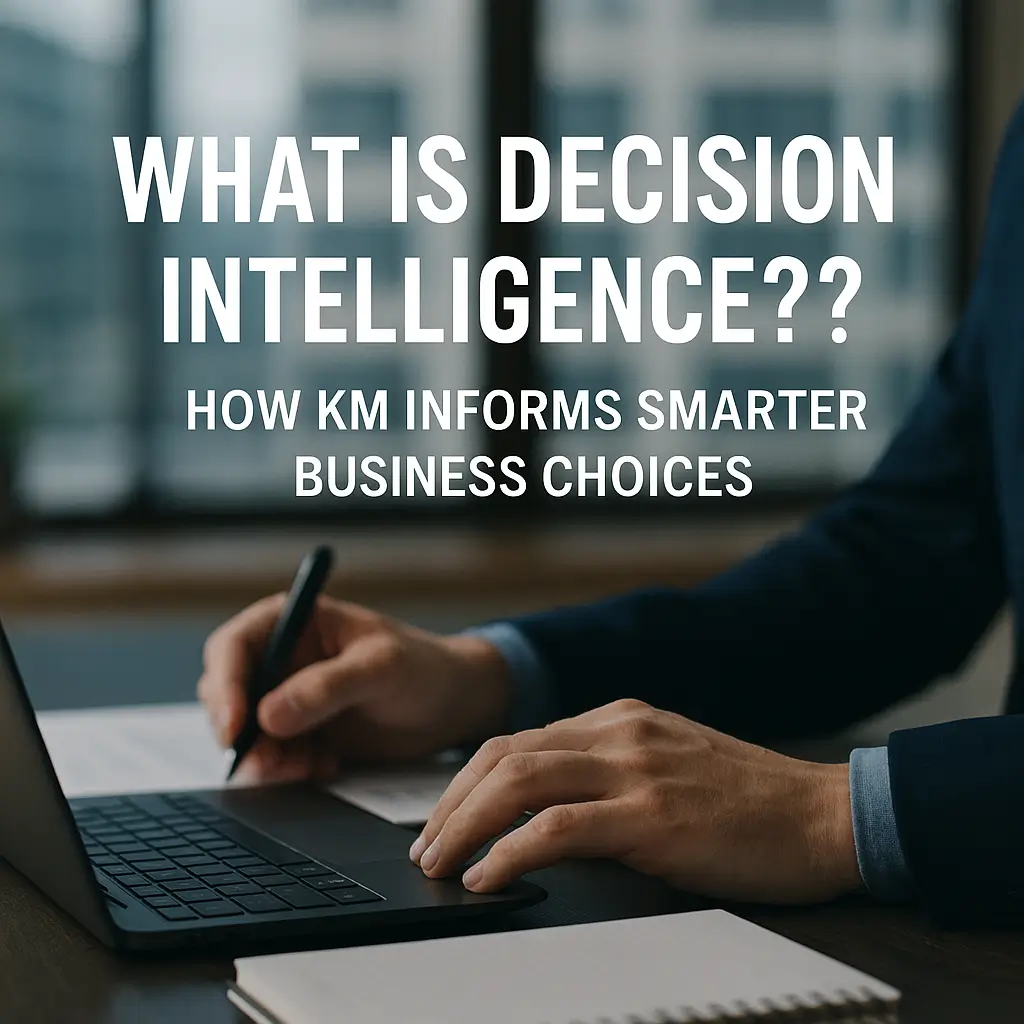We live in the age of big data, yet many organizations are drowning in information and starving for wisdom. You can have terabytes of data on customer behavior, market trends, and operational performance, but without a framework to translate it into action, it’s just noise.
This is the critical gap that Decision Intelligence (DI) aims to bridge. It’s not another buzzword for data analytics. It’s a practical discipline for turning information into better outcomes. And at its heart lies a simple, powerful truth: Decision Intelligence is impossible without effective Knowledge Management (KM).

What is Decision Intelligence, Really?
At its core, Decision Intelligence is the engineering of better decisions.
It’s a framework that combines data, analytics, AI, and—crucially—human knowledge to model, align, execute, and track decisions. Think of it as a structured process that moves from asking “What does the data say?” to “What should we do based on everything we know?”
A DI approach doesn’t just look at data points in isolation. It seeks to understand the context, the potential consequences, and the underlying mechanisms that lead to a result. It answers questions like:
- “If we change this pricing model, how will it affect customer retention and supply chain logistics?”
- “What knowledge did we generate from the last product launch that should inform this one?”
- “Who in the company has already solved a problem like this?”
This is where Knowledge Management stops being a supportive function and becomes the central nervous system of your organization’s intelligence.
The Missing Link: How Knowledge Management Fuels DI
Data tells you what is happening. Knowledge tells you why it’s happening and what to do about it. Decision Intelligence is the engine that uses both.
Knowledge Management provides the essential fuel for this engine in three critical ways:
1. Contextualizing Raw Data
Data on a spreadsheet might show a 20% drop in sales in a region. But why? A DI system powered by a robust KM platform can connect that data point to the contextual knowledge that explains it: the summary from a regional manager’s report (a tacit knowledge capture) noting a new competitor, or a support ticket analysis (structured data) showing a product flaw specific to that market. KM provides the narrative that turns a cold, hard number into a understandable situation.
2. Preventing the Repeating of Past Mistakes
A decision based solely on current data is a decision made in an amnesiac vacuum. Companies constantly reinvent wheels and rehash failed strategies because the knowledge of past failures and successes is locked away in forgotten folders or in the heads of retired employees. A KM system acts as an organizational memory. By documenting lessons learned, post-mortem analyses, and past project outcomes, it ensures that every new decision is informed by the full weight of the company’s experience.
3. Identifying and Connecting Expertise
Often, the best knowledge isn’t documented; it’s tacit. Decision Intelligence asks, “Who knows about this?” A modern KM system uses knowledge graphs and expert directories to map skills and experience. When a team is deciding on a new market entry strategy, the DI process can proactively identify and connect them with the product manager who led a similar entry five years ago—someone whose invaluable, unwritten lessons would have otherwise been missed.
Bringing It to Life: A Practical Example
Imagine a company deciding whether to discontinue a legacy product.
- A Data-Only Approach: Analytics show declining sales and profitability. The decision: discontinue it. The result: a key segment of long-term customers becomes furious and switches to a competitor, taking their business from other product lines with them.
- A Decision Intelligence Approach (Informed by KM):
- Data: Analytics show declining sales.
- KM Context: The system surfaces a old market analysis document showing this product is a “gateway” for a loyal, high-value customer segment. It also pulls up recent support tickets showing that while sales are down, usage among existing clients remains high.
- Tacit Knowledge: The DI process flags the product manager who launched it a decade ago. In a brief interview, she reveals that these customers are highly influential in online communities.
- The Smarter Decision: Instead of discontinuing, the company creates a new, premium version for this niche audience, retaining their loyalty and their business across other products.
The data was the same. The decision was radically different and more profitable because it was informed by knowledge.
How to Start Integrating KM and DI
- Audit Key Decisions: Identify the recurring, high-impact decisions in your organization (e.g., pricing, R&D investment, resource allocation).
- Map the Knowledge Supply Chain: For each decision, ask: “What information, data, and knowledge do we need to make this decision well? Where does it currently live?”
- Connect Your Systems: Ensure your KM platform (e.g., your intranet, wiki, CRM) isn’t a siloed library. Integrate it with your data analytics and business intelligence tools.
- Formalize Lessons Learned: Make post-project reviews and documentation a non-negotiable part of your workflow. This captured knowledge is fuel for future DI.
- Build Knowledge Graphs: Start mapping how people, projects, and expertise are connected. This makes tacit knowledge discoverable.
Conclusion: The Ultimate Symbiosis
Decision Intelligence is the future of strategic operation. But it is not a magic box you can install. It is a discipline that requires a foundation of accessible, contextual, and trusted knowledge.
In the end, Knowledge Management is what ensures your decisions are made not just with data, but with wisdom. It’s the difference between knowing what is happening and understanding what to do next.
Read: Data, Decisions, and Discoverability: A Smarter KM Framework
